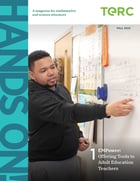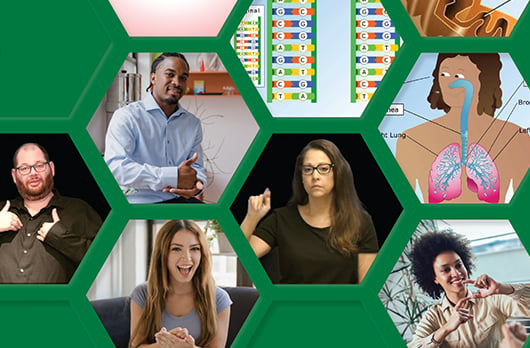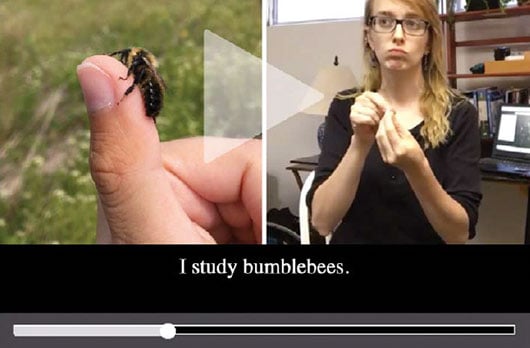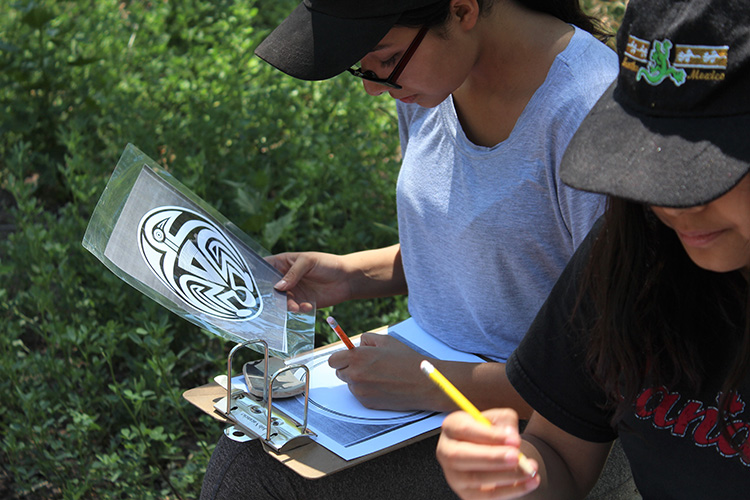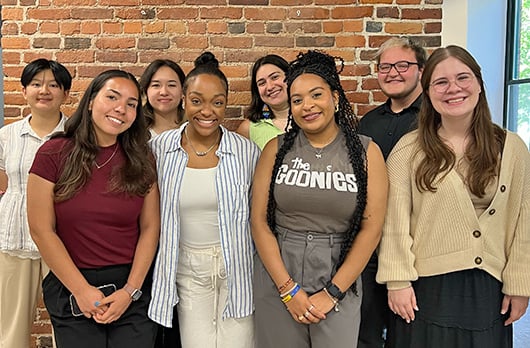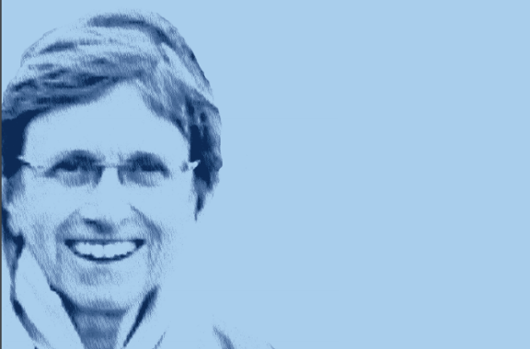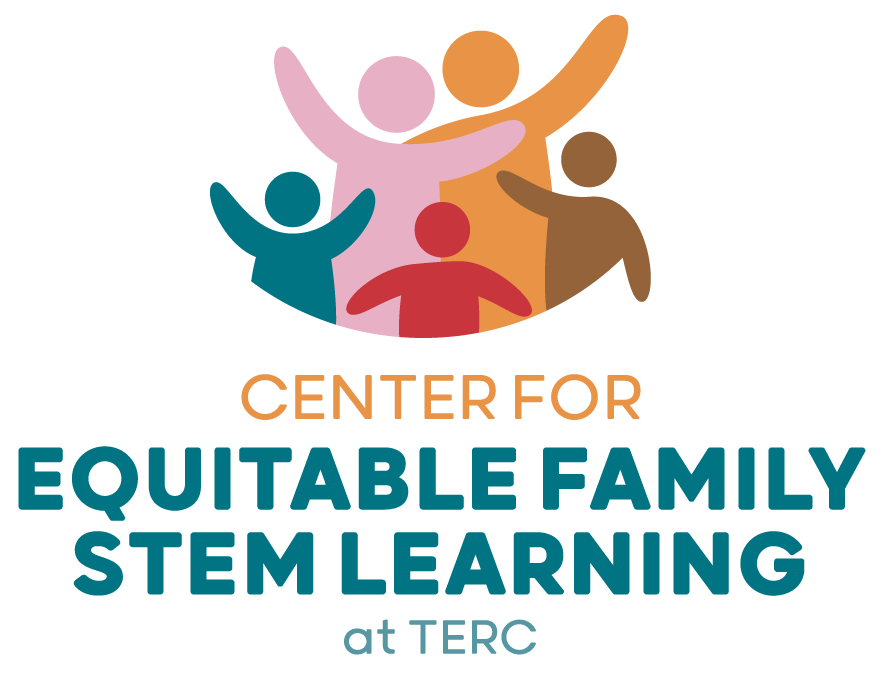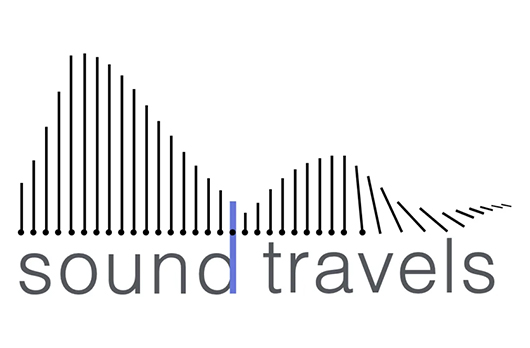TERC Blog
Increasing Student Interpreters' Ability to Accurately and Fluently Interpret STEM Content
THE NEED FOR A DIVERSE TALENT POOL OF STEM-LITERATE AMERICANS PREPARED FOR THE JOBS OF THE FUTURE IS UNDENIABLE. While progress has been made in broadening participation of underrepresented groups in STEM, data show that persons with disabilities remain underrepresented in science and engineering education and employment compared to their representation in the U.S. population (NCSES 2019).
This situation is often due to limited access to accommodations and support. For persons who are deaf or hard of hearing, this requires increasing the pool of interpreters who have knowledge of signed STEM vocabulary (Solomon et al. 2013; Grooms 2015, Lang et al. 2007), who also possess knowledge of the STEM content they will be called on to interpret (Vesel & Clark 2019; Gormally 2017; Kurz, Schick, & Hauser 2015), and will be able to interpret it fluently and accurately.
To address this need, TERC and Lamar University researched and developed a unique set of teaching and learning materials designed to provide student interpreters enrolled in Lamar’s four-year undergraduate interpreter training program with the knowledge and skills required to support students who are deaf or hard of hearing in successful learning of life science content. The immediate precursor for this work is a collaboration between the partners (NSF Award #1703343) that resulted in a prototype Signing Bioscience Dictionary (SBD) and new knowledge about what interpreters need to know and be able to do to fluently interpret STEM content (Vesel, Clark, & Robillard 2020).
WHAT TEACHING AND LEARNING MATERIALS WERE DEVELOPED?
SIGNING BIOSCIENCE DICTIONARY
Development of a beta version of the SBD involved review of the terms in the prototype SBD; identification of terms in the prototype that required adjustment to increase the contrast between the color of the avatar’s clothing and the character’s hands to make the hand motion easier to see during signing; and pinpointing terms within definitions that require understanding to comprehend their meaning. Terms within definitions were then incorporated into the term page interface and hyperlinked to their respective SBD pages. The navigation bar interface was also modified so that users could use the Back icon or Previous Word button to return to the original terms and definitions. Integration of these modifications allow users to navigate directly to terms within definitions and back to original terms without having to go to the alphabetical Letter List to find them. The resulting beta SBD includes 1580 primary terms. Of these, 1524 have terms below their definitions for a total of 7099 links beneath definitions. The beta version of the SBD is available from https://signsci.terc.edu/video/SBD/interpreters/ and https://signsci.terc.edu/ video/SBD.htm.
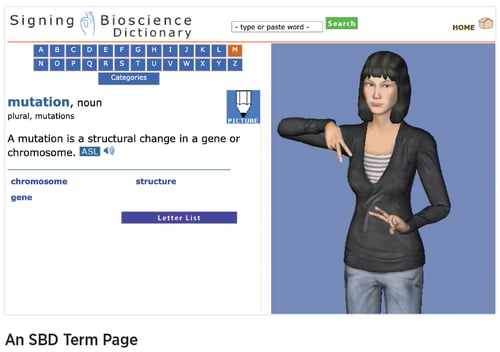
LIFE SCIENCE CONTENT SUMMARIES
Development of summaries of key life science content needed for fluent and accurate interpretation of undergraduate biology lecture material involved identifying life science content topics that emerged from review of the definitions and terms included in the content categories incorporated into the prototype SBD interface. To ensure accuracy of the material, we used the most recent edition of Campbell Biology, the text used for Lamar’s introductory undergraduate biology course, and material and images that the TERC team had researched and developed for another award and that had been reviewed by content experts. Prior to being finalized, draft versions of the summaries were reviewed by content experts at Lamar for accuracy and relevance to the undergraduate biology courses taught at Lamar. The summaries are available from https://signsci.terc.edu/video/SBD/interpreters/ and https://signsci.terc.edu/video/SBD/interpreters/contentsummaries.html.
FINGERSPELLING VIDEOS
Producing videos explaining the principles of fingerspelling and the application of these principles to STEM vocabulary encountered in undergraduate biology lecture involved Lamar team members who are native signers conducting an analysis of their implicit fingerspelling rules. This proved challenging and resulted in use of the strategies for teaching effective fingerspelling presented in James V. Van Manen’s book, The Fingerspelling Code: Linguistics of the ASL Alphabet (2018), as the primary resource for development. The two resulting videos explain the principles of fingerspelling and provide a review of these principles using examples and accompanying explanation. Both videos explain how to use the phonology of ASL to capture syllabification in signing and demonstrate how to include syllabification rather than citation format in fingerspelling. Syllabification for spoken languages divides words into syllables and influences their pronunciation. In a similar way, for ASL prior handshapes influence the phonology of handshapes that follow. This type of research is rare if found at all in sign language linguistics. An additional component of development included integration of elements of universal design into the interface. Once selected, users can view the video in sign with or without captions or listen to it in English with or without simultaneous sign or voice overlay. They can also exercise the option to increase or decrease text size, loudness, and contrast, and play and replay all or part of the video as often as needed. The videos and accompanying transcripts are available from https://signsci.terc.edu/video/SBD/interpreters/index.html and https://signsci.terc.edu/video/SBD/interpreters/fsprinciples-explained.html; https://signsci.terc.edu/video/SBD/interpreters/fsprinciplesreview.html.
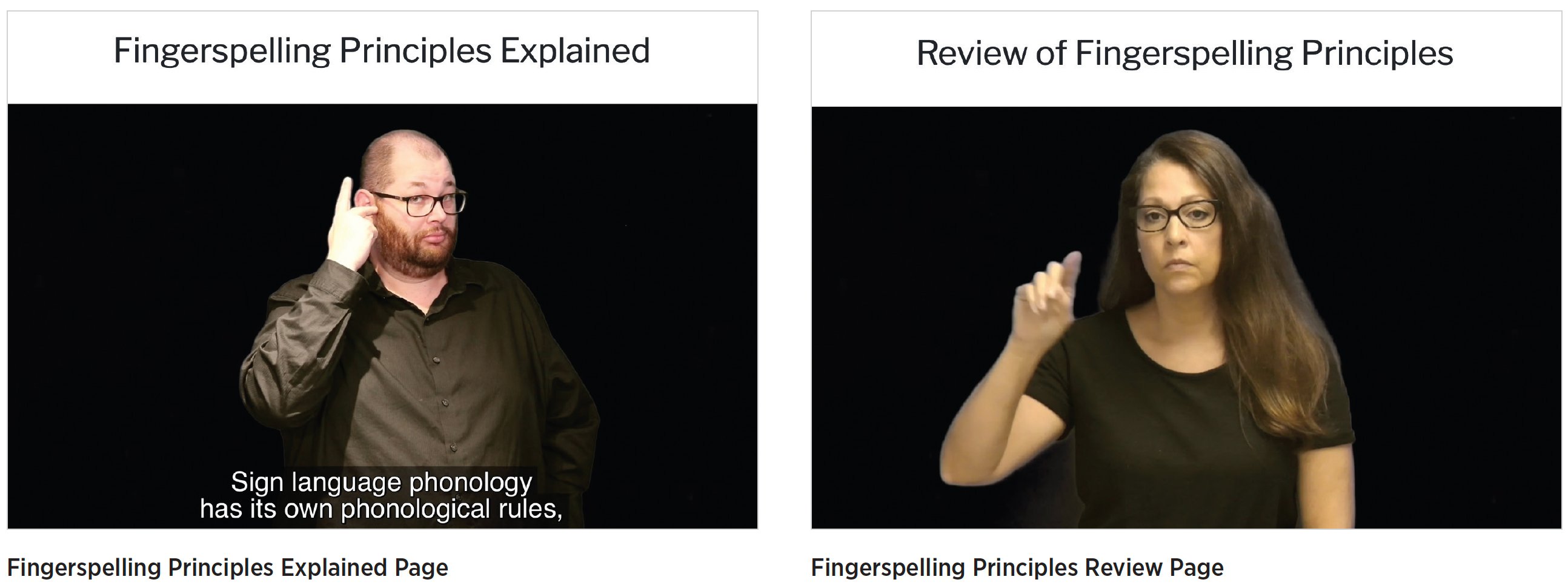
WHAT DOES OUR RESEARCH SHOW?
Evaluation of the materials involved a two-phase study that focused on Genes and Heredity. This category was selected because many of the terms included in it must be fingerspelled. The Lamar team had primary responsibility for all aspects of instruction associated with both parts and for data collection. Responsibilities for data preparation and analysis were shared among TERC and Lamar. During Phase I, students focused on studying and mastering the genetics vocabulary included in the SBD and related content.
During Phase II, they focused on learning and becoming able to use syllabification in signed fingerspelling. The Lamar team mentored and guided participants during both phases. A video narrative of a genetics lecture produced in spoken language provided the measure used to determine the effectiveness and accuracy of participants’ interpreting ability using a pre- and post-design. The presentation was interpreted at the beginning and end of the first phase. This same video was used weekly to monitor fluency of interpretation during the second phase.
To recruit participants, flyers were posted throughout the Department of Deaf Studies and Deaf Education building so that students were aware of the opportunity. Faculty also announced it in their classes and gave some students extra credit for participating. This resulted in a study sample comprised of 24 undergraduate ASL student participants. They represented Lamar’s three Department of Deaf Studies and Deaf Education tracks. These tracks include ASL Teaching K-12, Educational Interpreting, and Advocacy.
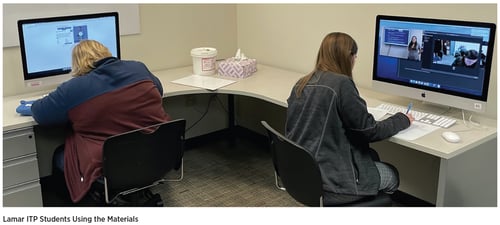
To analyze our data, we organized our results around each of four research questions: 1) How do Lamar undergraduate students use the SBD, biology content summaries, and videos? 2) How effective are the SBD and content summaries in increasing Lamar undergraduate students’ ASL biology vocabulary and biology content knowledge? 3) How effective are the SBD, content summaries, and videos in increasing Lamar undergraduate ASL students’ capacity to interpret typical undergraduate biology lecture material accurately and fluently? 4) What additions and/or changes would make the materials more effective?
Key findings were as follows: Paired samples statistics and paired differences showed participants’ knowledge of STEM vocabulary was significantly improved following use of the SBD (t (23)=8.14, p,.001; mean pretest=8.23 and mean posttest=36.56). Their ability to interpret typical biology lecture material was improved after learning the SBD vocabulary (t (23)=3.83, p,.001; mean pretest 2.5 and mean posttest=12.5). They also show that after watching the videos of the fingerspelling principles and working with the research team on applying those principles that fingerspelling scores significantly improved (t(23)=1.81, p=.04; mean pretest=9.8 and mean posttest=11.6). There was no significant improvement in participants’ knowledge of biology content. (Questions 2 & 3)
Observations and post-use survey responses show that participants used the SBD, to look up terms and definitions in ASL and English; see words signed; view illustrations; learn new signs; and learn more about science. Most participants used the SBD to learn new signs and to learn the meaning of a term either because they did not know it or to help them review their knowledge of an aspect of biology content. They were generally satisfied with the information that was available for each term and with the accuracy of the signs but preferred a human signer to an avatar. All participants found that use of the dictionary made learning science terms and definitions easier. In general, they used the content summaries and found them interesting. (Question 1)
Based on participants’ post-use survey responses, a revised version of the SBD that incorporates a human signer is needed. Additional and different materials and strategies are also needed to fully understand the meaning of STEM terms and to enable students to develop their understanding of fundamental STEM content incorporated into undergraduate lecture material. (Question 4)
WHERE ARE DOWNLOADS AVAILABLE?
For more information about our research and to access materials, visit our project website at https://signsci.terc.edu/
Acknowledgements
This material is based upon work supported by the National Science Foundation under Grant #2019843. All opinions, findings, conclusions, and recommendations expressed herein are those of the authors and do not necessarily reflect the views of the funder.
Instructor R. Sean Hauschildt and Graduate Student Tabitha Venable all had important roles in researching and developing the materials presented in this article. Bridge Multimedia, a content services provider and project partner, had an important role in incorporating the elements of universal design into the videos. We are grateful to the Lamar ITP students involved in the project from whom we learned so much.
Authors
Judy Vesel is a Principal Investigator at TERC. She has degrees in Biology, Linguistics, and Education. She was the Principal Investigator for the Leveraging Learning and Science for Today and Tomorrow projects (funded by NSF). She is the Principal Investigator for a body of work referred to as “Signing Math & Science” funded by NSF and the U.S. Department of Education. Her experience as an educator and administrator extends from the primary grades through high school. Ms. Vesel has presented her work at many recent conferences including meetings of the American Association of Museums (AAM), Assistive Technology Industry Association (ATIA), 2022 IUSE Summit, Association of Science and Technology Centers (ASTC), and Closing the Gap. E-mail: judy_vesel@terc.edu
M. Diane Clark is a full Professor and Chair of the Department of Deaf Studies and Deaf Education at Lamar University. Prior to coming to Lamar, she was a full professor at Gallaudet University and Program Director for their Ph.D. program in Critical Studies in the Education of Deaf Learners. She has a background in the cognitive development of deaf individuals. Her current publications have included the development of the Visual Communication and Sign Language Checklist, the Beliefs and Attitudes about Deaf Education Questionnaire, as well as projects that investigate successful deaf readers. E-mail: diane.clark@lamar.edu
Tara Robillard is a Senior Researcher and developer at TERC. She has degrees in Marine Science and Science Education and taught at the high school level. Her research interests focus on accessibility and differentiation, especially the use of universally designed technology innovations and curricula to improve achievement in STEM for all students. E-mail: tara_robillard@terc.edu
Resources
Signing Bioscience Dictionary
https://signsci.terc.edu/video/SBD/interpreters/
https://signsci.terc.edu/video/SBD.htm
Life Science Content Summaries
https://signsci.terc.edu/video/SBD/interpreters/
https://signsci.terc.edu/video/SBD/interpreters/contentsummaries.html
Fingerspelling Videos
https://signsci.terc.edu/video/SBD/interpreters/index.html
https://signsci.terc.edu/video/SBD/interpreters/fsprinciplesexplained.html
https://signsci.terc.edu/video/SBD/interpreters/fsprinciplesreview.html
References
Gormally, C. (2017). Deaf, hard-of-hearing, and hearing signing undergraduates’ attitudes toward science in inquiry-based biology laboratory classes. CBE—Life Sciences Education, 16(1), ar6.
Grooms, C. (2015). Interpreter competencies in science, technology, engineering, and mathematics as identified by deaf professionals. (Master’s thesis, Paper 18). Retrieved from: http://digitalcommons.wou.edu/theses/18/
Kurz, K. B., Schick, B., & Hauser, P. C. (2015). Deaf children’s science content learning in direct instruction versus interpreted instruction. Journal of Science Education for Students with Disabilities, 18(1), 23-37.
Lang, H., Hupper, M., Monte, D., Scheifele, P., Brown, S., & Babb, I. (2007). A study of technical signs in science: Implications for lexical database development. Journal of Deaf Studies and Deaf Education, 12, 65–79.
National Center for Science and Engineering Statistics (US) [NCSES] (2019). Women, minorities and persons with disabilities in science and engineering: 2019. Data Report Series. Arlington (VA): National Science Foundation (US). NSF Pub. No. 19-304.
Solomon, C., Graham, S., Marchut, A. & Painter, R. (2013). Where are the leaks for deaf and hard-of-hearing people in the science, technology, engineering, and mathematics (STEM) pipeline? Paper presented at the 2013 annual meeting of the American Educational Research Association.
Van Manen, J.W. (2018). The Finger Spelling Code: Linguistics of the ASL Alphabet. Empyreal Press.
Vesel, J., & Clark, M.D. (2019). Increasing STEM signing knowledge of undergraduate student interpreters: Evaluation Report. Retrieved from: https://sign-sci.s3.amazonaws.com/publications/IUSE.EvaluationReport.2019. FINAL.pdf
Vesel, J., Clark, M. D., & Robillard, T. (2020). Introducing the Signing Bioscience Dictionary (SBD). Hands On!, TERC, Inc.


